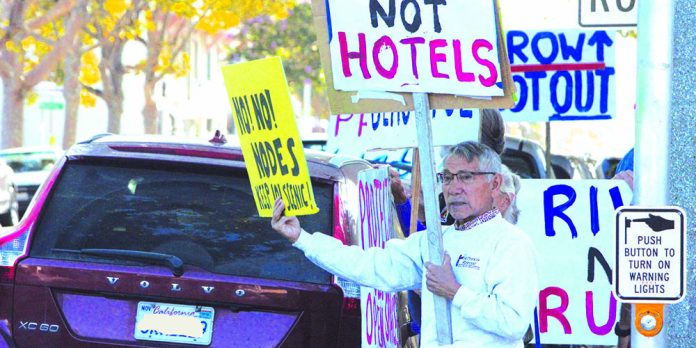The San Benito County Board of Supervisors delayed a decision Sept. 10 to allow expanded commercial development at four Highway 101 intersections.
The vote was delayed until Sept. 24 because planners added some changes prior to the meeting, but all five supervisors expressed support for the proposal.
The four “nodes,” as they are called by planners, are located at Betabel Road and Highway 129/Searle Road in San Juan Bautista, and Rocks Ranch and 101 Livestock Market in Aromas.
A “node,” as defined by the county, is “a concentration of development at or within a reasonable distance of an intersection or interchange.”
Opposition and support
A group of people from Preserve Our Rural Communities, which opposes the zoning changes, staged a rally outside the county administration building before the meeting. The group submitted a petition to the supervisors with the names of 250 people, most of which stated they lived in Aromas and Prunedale, with a handful in areas such as San Jose and Santa Cruz County. The community of Aromas straddles three counties—San Benito, Monterey and Santa Cruz—and Prunedale is in Monterey County.
Twenty-six people spoke during the public comment period, with the majority urging supervisors to rethink the plan.
Tom Karis of Aromas said he opposed the project based on aesthetics, as well as traffic and water concerns.
“Hotels up to 65 feet tall, gas stations, shops and residences will permanently degrade the scenic corridor through San Benito County,” he said. “There must be a less destructive way to raise revenue for the county.”
Jackie Morris-Lopez of San Juan Bautista said officials are “blatantly ignoring” the county’s natural resources such as Pinnacles National Park as a way to draw tourists to the area.
“These nodes reek highly of commercialism and inauthentic sites,” she said.
On the other side of the issue, the supervisors received letters of support for the proposal from the San Benito County Chamber of Commerce, Central Coast Hispanic Chamber of Commerce, San Benito County Economic Development Corporation, San Benito County Business Council and Hollister Fire Fighters Association Local 3395. The letters were submitted with the help of former Hollister mayor Victor Gomez of Pinnacle Strategy, a local consulting firm.
Greg Weiler, whose family owns part of the property at Highway 129 and Searle Road, said the proposal is “well planned out” and “highly regulated.”
“I want to assure the public that this is not a land grab,” he said.
Ben Bingaman, whose family owns Rocks Ranch, said the site is less than 1 percent of the total five square miles of property. He added that a lot of misinformation has been circulating throughout the process, and that he looked forward to having dialogue with residents.
“I was told that we are going to create a water park,” he said. “That’s never been brought to us.”
Supervisor Anthony Botelho said the county needs new tax revenue to maintain and expand its services. He added that the “constraining” ordinance as proposed allows preservation of the county’s rural character, while providing it with much-needed funds.
“We’re not sustainable right now,” he said. “I’m looking forward to a well-planned project at some date. It may be years before people take advantage of the zoning opportunities, but we have to keep going forward.”
Current state of the nodes
The listed owners of the node properties are family trusts located from the Monterey Peninsula to San Juan Bautista. Highway 129/Searle Road is the only site with multiple owners listed, who addresses are from Pacific Grove, Irvine, Watsonville, Salinas and three from San Juan Bautista.
Two of the nodes (Betabel and Livestock 101) already have commercial development: The Betabel RV Park and 101 Livestock Market.
Jim Warren, owner of 101 Livestock Market, said the business, which opened in 1975, has already been promoting San Benito County’s agricultural resources as “the most modern livestock market in the western half of the United States.”
Weiler said the front of his property, which lines Highway 129, is used as a turnout for trucks. A gas station was once located on the property about 50 years ago, according to Weiler.
“For years we have this piece of land that can’t be farmed,” he said. “It’s just sitting there.”
The properties, totaling about 298 acres, would be converted to regional commercial zoning which, according to the 2035 General Plan approved in 2015, provides “areas that function as destinations for commercial activity serving the regional population.” Such developments as gas stations, hotels and restaurants could be constructed on the property.
Under regional commercial zoning, retail space is limited to 85,000 square feet per node, and no more than 125 hotel rooms and 30 residential units can be built within each area.
According to principal planner Darryl Boyd, the zoning changes follow the county’s 2035 General Plan, which encouraged the development of nodes along highway interchanges.
On Sept. 4, the county planning commission recommended modifications to the code and zoning maps. In particular, the Betabel node was reduced from 55.5 acres to 29 acres, and the Highway 129/Searle Road node was shrunk from 39.7 acres to 33. The Rocks Ranch node, meanwhile, grew by five acres to 77.
The update also added a requirement that all proposed development must show proof of a sustainable water source.
Should the zoning changes pass muster with the supervisors on Sept. 24, development would not be happening anytime soon. Each node would then need approval of a master development plan, which outlines the property’s site plan and landscaping, among many other things.
Once approved, major developments that are consistent with the master plan would then have to go through another round of county approvals.
“Adopting the ordinance is not going to allow anyone to go out and put a shovel in the ground and disturb the dirt,” Boyd said. “This is putting the framework in place so that in the future, at any of these nodes, people can come in and apply for conditional use permits and go through the master development process.”
The code also discourages the creation of strip commercial developments along the corridor, he added.
“Some people might be envisioning what is being proposed is like the Gilroy outlet malls,” he said. “That’s not what these are.”










